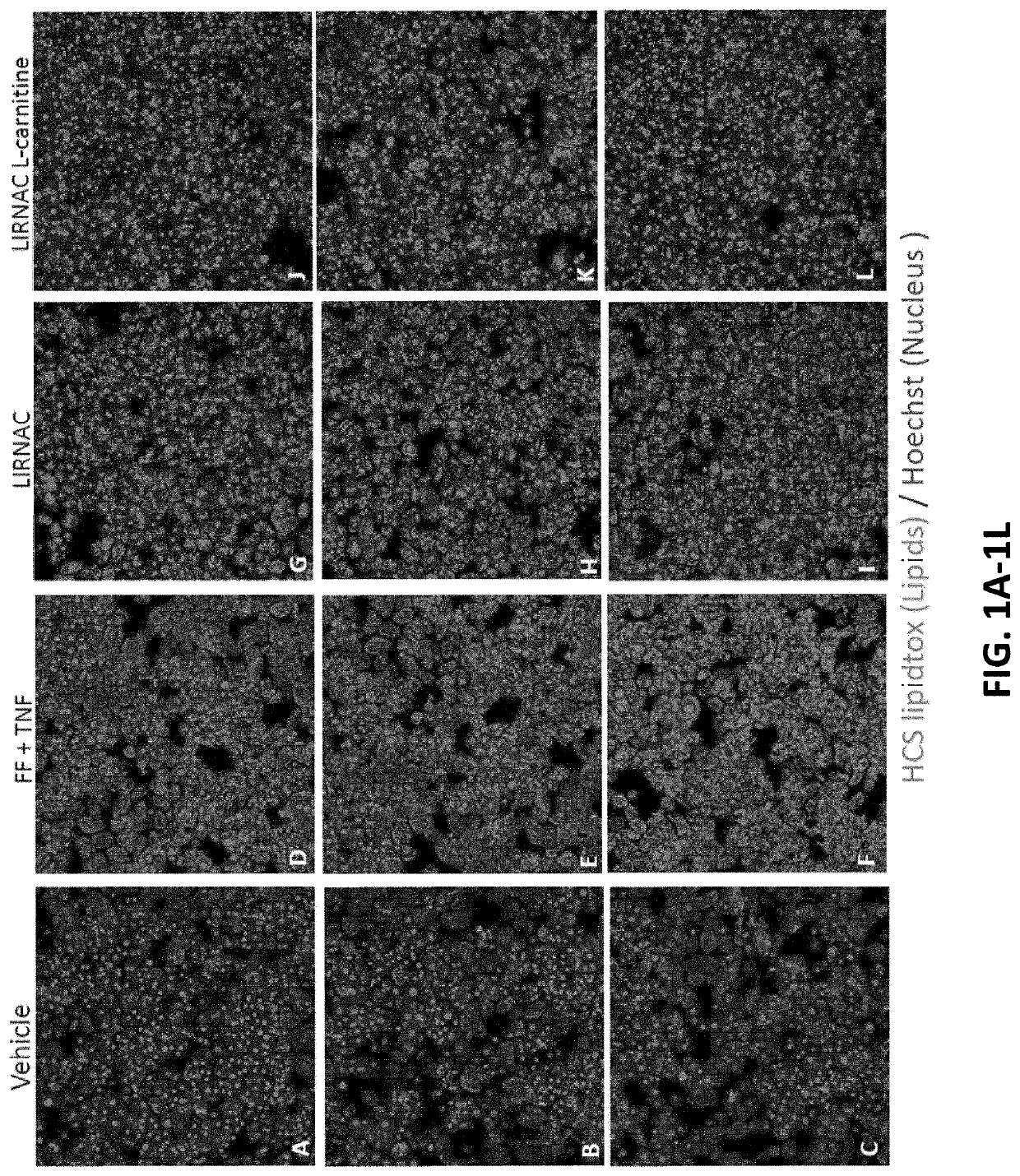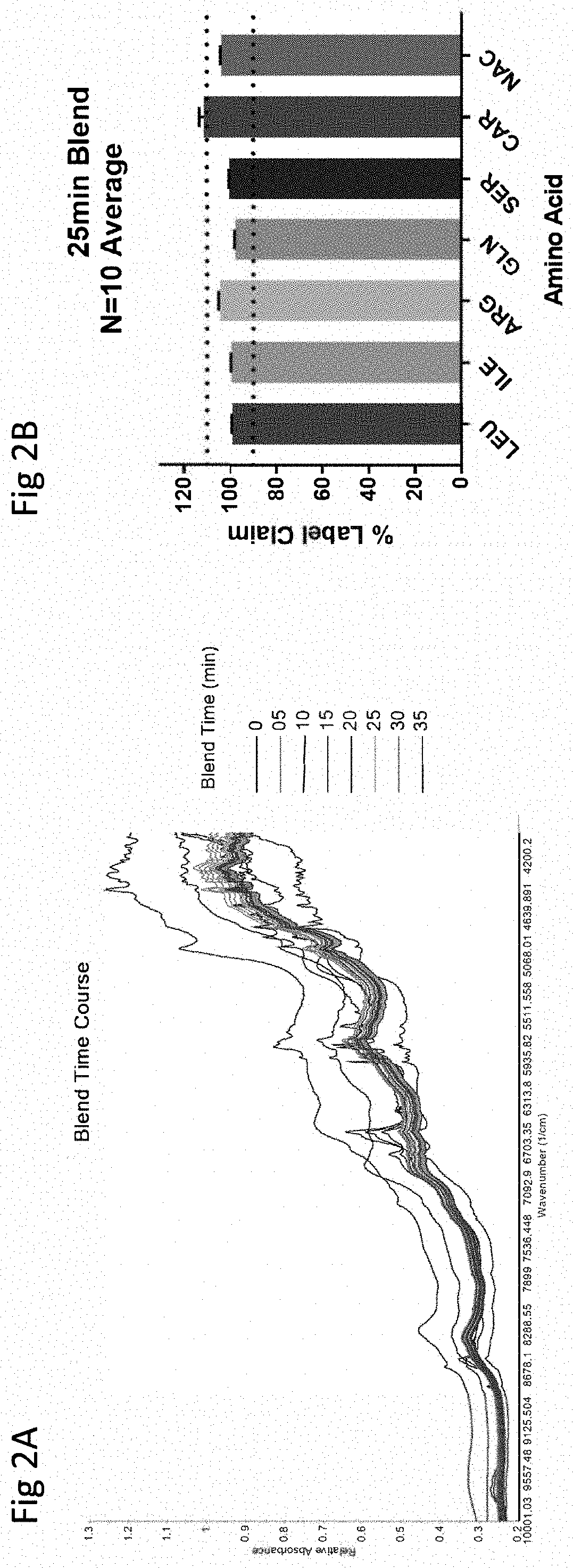Compositions and methods for the treatment of liver diseases and disorders
- Summary
- Abstract
- Description
- Claims
- Application Information
AI Technical Summary
Benefits of technology
Problems solved by technology
Method used
Image
Examples
example 1
e Model for Steatosis and Inflammation
[0350]Hepatocyte lipotoxicity appears to be a central driver of hepatic cellular injury via oxidative stress and endoplasmic reticulum (ER) stress. The ability of amino acids to influence steatosis (lipid accumulation) and inflammation in hepatocytes was assessed using human primary hepatocytes (Sekisui Xenotech).
Cell Seeding and Maintenance
[0351]Primary hepatocytes lot nos. from one healthy human donor were seeded on day 0 at density of 6E+04 cells in 96 well optical microplates (Thermofisher) in hepatocyte plating media (William's E medium (Gibco) supplemented with 10% heat-inactivated FBS (Atlanta Bio), 2 mM Glutamax (Gibco), and 0.2% Primocin (InVivoGen) and incubated for 6 hours at 37° C., 5% CO2. After 6 hours, cells were washed twice and incubated overnight at 37° C., 5% CO2 in hepatocytes plating media. On day 1, cells were washed twice and incubated for 24 h in Hepatocytes defined medium (Corning) supplemented with 2 mM Glutamax (Gibco)...
example 2
e Model for NASH
[0358]Primary human hepatocytes (PHH) were used as a model to assess the ability of amino acids to influence fundamental aspects of NASH progression. Lipotoxicity is a major driver of hepatocellular injury due to dysregulated lipid metabolism, oxidative stress and mitochondrial dysfunctions. The PHH model was employed to assess the ability of amino acids to reduce disease phenotype by lowering lipotoxicity (lipid) and inflammation (MCP1 secretion), while promoting liver function by maintaining or increasing albumin secretion and maintaining or increasing urea production.
Cell Seeding and Maintenance
[0359]PHH from two healthy human donors (Lonza, TRL) were seeded on day 0 at density of 6e04 cells in 96 well optical microplates (Thermofisher) in hepatocyte plating media (William's E medium, WEM) (Gibco) supplemented with 10% heat-inactivated FBS (Atlanta Bio), 2 mM Glutamax (Gibco), and 0.2% Primocin (InVivoGen) and incubated for 6 hours at 37° C., 5% CO2. After 6 hours...
example 3
e Model for Measuring Triglyceride Level
[0380]Triglyceride (TG) accumulation in the cytoplasm of hepatocytes is a hallmark of NAFLD / NASH. The ability of amino acids to reduce triglyceride level was assessed using human primary hepatocytes (Lonza, TRL).
Cell Seeding and Maintenance
[0381]Primary hepatocytes from two healthy human donors (hepatocyte donor 2 and 3) were seeded on day 0 at density of 3.5e05 cells in 24 well collagen coated plate (Corning) in hepatocyte plating media (William's E medium (Gibco) supplemented with 10% heat-inactivated FBS (Atlanta Bio), 2 mM Glutamax (Gibco), and 0.2% Primocin (InVivoGen) and incubated for 6 hours at 37° C., 5% CO2. After 6 hours, cells were washed twice and incubated overnight at 37° C., 5% CO2. On day 1, cells were washed twice and incubated at 37° C., 5% CO2 for 24 h with hepatocytes defined medium (Corning) supplemented with 2 mM Glutamax (Gibco), and 1× Penicillin / Streptomycin (P / S).
Amino Acids Pre-Treatment
[0382]On day 2, cells were wa...
PUM
| Property | Measurement | Unit |
|---|---|---|
| Temperature | aaaaa | aaaaa |
| Angular velocity | aaaaa | aaaaa |
| Molar density | aaaaa | aaaaa |
Abstract
Description
Claims
Application Information
 Login to View More
Login to View More - Generate Ideas
- Intellectual Property
- Life Sciences
- Materials
- Tech Scout
- Unparalleled Data Quality
- Higher Quality Content
- 60% Fewer Hallucinations
Browse by: Latest US Patents, China's latest patents, Technical Efficacy Thesaurus, Application Domain, Technology Topic, Popular Technical Reports.
© 2025 PatSnap. All rights reserved.Legal|Privacy policy|Modern Slavery Act Transparency Statement|Sitemap|About US| Contact US: help@patsnap.com


